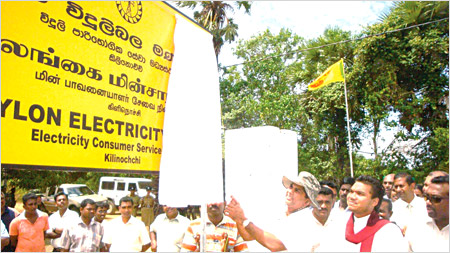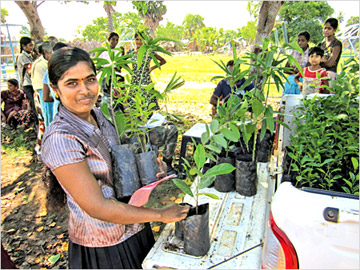Kilinochchi, now a nerve centre of activity
By P. Krishnaswamy
The Kilinochchi district which was the main area of LTTE
concentration and the nerve centre of terrorist activity, with people's
welfare and development activities totally neglected, saw the silver
lining of peace and prosperity after Government Forces recaptured the
district in January 2009.
|

Namal Rajapaksa MP opens an Electricity Consumer Service Centre |
In May 2009, the UPFA Government initiated measures to restore the
city to its former state. Many accelerated development projects were
launched. Huge amounts of funds were allocated by the Ministry of
Economic Development, the provincial administration, other line
ministries and Local Government bodies for development projects in the
spheres of agriculture, infrastructure, road network, industries,
housing and livelihood facilities.
The district was mine-infested with mines planted indiscriminately in
the district.
A major part of the demining process has already been completed, with
only a small area yet to be cleared.
Displaced people have been resettled in areas where they lived in the
pre-conflict period. A total of 62,848 anti-personnel mines, 252
anti-tank mines and 214,571 unexploded objects have already been cleared
from the mine-infested areas. A five sq. km area is presently under
demining and only a 12 sq. km area is yet to be demined.
The details of the different development, infrastructure and
livelihood activities so far undertaken and the amounts spent are given
below on the basis of details provided by the Government Agent,
Kilinochchi.
Reconstruction, renovation
 |
| Plants for
agricultural promotion distributed |
 |
| A road under
construction |
 |
| A family
engaged in Other Field Crops cultivation |
The amount spent for reconstruction of buildings, provision of
electricity and renovation of roads rapidly increased from Rs. 69
million in 2009 to Rs. 18,244 million in 2012. For 2010 the amount
allocated was Rs. 3,269 million and for 2011 Rs. 7,193 million.
Over 10,1260 houses have been completed at an expenditure of Rs.
8,100 million; 3,671 houses are under construction while the total
number of houses still needed is 10,261 which will be constructed in the
future. Under the Indian Government's Housing scheme (Stage III) 6,810
houses have already been completed.
Rs. 153 million was spent on livestock development and animal
production to overcome malnutrition among the population and to generate
income for low income groups. Over 157,674 bushels of seed paddy were
distributed among farmers in 2012 and the fertiliser subsidy distributed
was 16,382 MT. About 17,159 kg of green gram, 56,440 kg of ground nut,
12,515 kg of black gram and 12,770 kg of cowpea and 73,080 kg of red
onion were distributed among farmers for the cultivation of highland
crops.
Agricultural products markedly increased from 3,040 MT to 94,300 MT.
In these four years the production of highland crops (Other Field Crops)
also increased from 1,672 MT to 12,100 MT. Production of fruits rose
from 1,170 MT in 2009 to 96,127 MT in 2012. The total acreage under
cultivation under these projects is 33,350 acres.
One District General Hospital and one Base Hospital is also
functioning in the district. Large amounts of funds have been invested
for the renovation and provision of facilities in the District General
Hospital and other State medical institutions. Rupees 272 million has
been spent for the District General Hospital while Rs. 144 million has
been allocated for ongoing projects to the hospital.
Hospital facilities
New facilities at the District General Hospital include pipe medical
gas system, strengthening of the sterilisation unit, establishment of
the central air-conditioner system and provision of theatre medical
equipment.
Rupees 15,294.50 million has been spent for road development and the
extent of the roads developed is 371.91 km.
The RDA Paranthan-Puthukudiyiruppu highway has been
renovated/reconstructed at an expenditure of Rs. 10,560.50 million.
Over 183 km of rural roads have been renovated at an expenditure of
Rs. 3,650 million and RDD roads extending a distance of 56.51 km were
renovated at an expenditure of Rs. 1,084 million. Rs. 1,084 million has
been allocated collectively by the Ministry of Economic Development
(Conflict Affected Regional Emergency Project), the Ministry of Local
Government and the Provincial Council (PSDG) for 16 rural roads
projects. Forty percent of the work has been completed.
Forty-nine rural electricity projects have already been completed at
an expenditure of Rs. 623 million. Work on 10 electricity schemes are in
progress for which an amount of Rs. 271 million has been allocated while
42 schemes at an expenditure of Rs. 584 million are also to be
undertaken during the period 2013-2016.
Grid substation and transmission lines have been established at an
expenditure of Rs. 3,200 million to ensure an uninterrupted power
supply, enhanced living standards, and the introduction of more
industries.
The total expenditure incurred on water supply and sanitation
development projects is Rs. 22,985 million of which the amount spent for
the major Jaffna-Kilinochchi Water Supply project is Rs. 21,717 million,
the amount spent for the rehabilitation of the Kilinochchi water supply
scheme is Rs. 982 million, the amount spent for the improvement of
community-based rural water supply and sanitation in post-conflict areas
is Rs. 268 million and the amount spent on the construction of the
Kallaru water supply scheme is Rs. 18 million.
The number of cooperative societies in existence in 2009 was 91 and
this was increased to 121 in 2012 after strengthening the existing ones
and starting 30 new cooperative societies.
These include Multi-Purpose Cooperative Societies, Palmyrah Resource
Cooperative Societies, Secondary Cooperative Societies, Fisheries
Cooperative Societies, Thrift and Credit Cooperative Societies and
Livestock Breeders' Cooperative Societies. An amount of Rs. 176.83
million was allocated for the construction of buildings for cooperative
societies.
University buildings
The work on the construction of the building for housing the
Engineering and Agricultural Faculties of the Jaffna University has been
partly completed. Work on the construction of the building for the Sri
Lanka - German Technical College (Ministry of Youth Affairs and Skills
Development) also has been partly completed. At the Pachchilaipalli
village 100 toilets were constructed at an expenditure of Rs. 10 million
and a social care centre was constructed at an expenditure of Rs. 1.2
million.
Over 126 disabled persons received Rs. 3,000 every month and another
246 disabled persons received equipment.
The question of allocating funds for establishing a Central Bus Stand
and CTO is also under consideration. Rs. 200 million has been allocated
for the construction of a building for the public library.
Vehicles abandoned by the people who fled to safeguard their lives at
the peak of confrontations remained heaped at the vehicle yard and were
given back to the rightful owners. Over 2,271 motorbikes and nearly
5,500 other vehicles were given to the owners under this program.
Infrastructure development at Ponnagary GN Division which is an
important educational and industrial hub was also focused on with the
provision of road network, water supply, drainage and power supply.
Under the program for strengthening and upgrading local democratic
institutions, the Karachchi Pradeshiya Sabha is to be upgraded as an
Urban Council and a new Pradeshiya Sabha for Kandawalai is to be
established. The relevant papers have already been forwarded to the
Ministry of Local Government and Provincial Councils. Investments have
been made for imparting training to unemployed youth in an effort to
help them to engage in small-scale industries and self-employment
ventures.
Rs. 1.90 million has been spent for providing training to 87 youth
under the Star Garments training program. Rs. 12.70 million has been
spent for imparting bus driver training to 96 youth and Rs. 0.02 million
has been invested for palmyrah-leaf-based training to 20 youths. |


